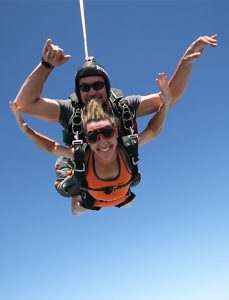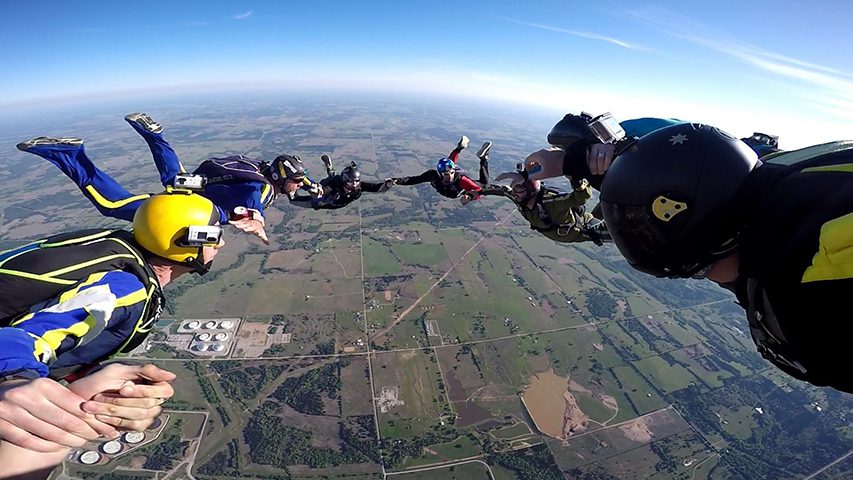If you’re curious about skydiving but too petrified to do it, consider Stephen Stewart, owner of Skydive Airtight in Skiatook. He used to be afraid, too.
“I am terrified to death of heights,” he says. “But depth perception ends at 1,500 feet for most people. When you’re 12,000 feet in the air, your depth perception is gone.”
And so is your fear of heights.
Stewart, who has made more than 7,500 jumps, says a lot of people’s anxiety comes from the fear of the unknown. He gives customers a thorough look at what to expect – the harness and its fit, properly exiting the plane, an overview of freefall, opening the parachute, and proper landing techniques. While skydiving solo is an option after daylong training, most people choose a tandem dive strapped to an instructor for their first time.
“Giving them an idea of what will happen helps trepidation,” he says. “But when they get to the ground and it’s over, the leap into the unknown winds up being their favorite part.”
Andy and Alyssa Beck co-own the Oklahoma Skydiving Center in Cushing. Andy received a voucher for a jump as a Christmas present years ago – and has made more than 12,200 dives since then. He describes a typical tandem jump.
[media-credit name=”Oklahoma Skydiving Center” align=”alignleft” width=”316″] [/media-credit]
[/media-credit]
“In the plane, you get connected to an instructor,” he says. “The plane has a large cargo door. Students sit on the edge and cross their arms. As soon as we leave, we accelerate to 80-120 miles an hour.
“We ask students to do something called an arch – a key building block to skydiving. Their hips move forward, their pelvis is in a curve, so the air moves smooth around the body. Once we’re out and arched, we will freefall for full minute. In that time, we’ll cover almost 2 miles of altitude.
“Once we’ve done our 60 seconds, the instructor will open the parachute, and we can talk just like normal. We’ll descend at about 20 miles per hour – about the speed of a brisk bike ride.
“People ask what it feels like. A lot of people are apprehensive; they think it’s like a roller coaster and you’ll lose your stomach. It’s actually all the adrenaline and fun without losing your stomach. It’s a pure shot of adrenaline, that’s for sure.”
To prepare for a dive, both Stewart and Beck recommend dressing appropriately; the air can be as much as 30 degrees cooler 2½ miles up. Wear sneakers unless you want to lose a shoe in the wind. Both owners recommend a snack or light, small meal beforehand.
“Eat, but don’t eat a whole lasagna,” Beck says.
Both Stewart and Beck try to alleviate fears of new divers and serve as ambassadors for the sport.
“We want them to have fun,” Beck says. “And we want to share a sport we’re passionate about.”


























